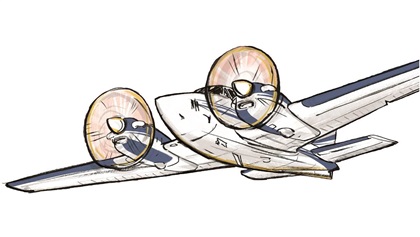What went wrong? A momentary lapse
Did a silenced warning seal this flight’s fate?

A person who was clearing trees across the road from where the accident occurred witnessed the crash. As he approached the airplane, which had shattered in pieces after hitting a nearby communications tower, it was clear there was nothing he could do to save the pilot, the sole occupant of the Beechcraft King Air C90GT.
Only 36 minutes earlier that morning, the pilot—who managed and flew the King Air for the owner—had picked up the owner and two passengers at Rigrtona Airport (13PA) in Tidioute, Pennsylvania, and dropped them off at Nemacolin Airport (PA88) in Farmington, Pennsylvania.
As the National Transportation Board (NTSB) investigators arrived at the accident scene near Morgantown they were faced with the difficult task of piecing together this tragedy’s puzzle and finding answers to the many questions it posed.
Seeking answers
That June morning, the 22,000-hour airline transport pilot approached Rigrtona Airport for landing. He engaged the King Air’s enhanced ground proximity warning system (EGPWS) “terrain inhibit” switch—as was his routine when flying into this airport, which was not in the system’s database—to allow the aircraft to operate without nuisance warnings at the airport. He would then disengage the inhibit switch shortly after takeoff.
Once everyone had settled in, the King Air departed 13PA and climbed to 8,000 feet msl for the 21-minute flight from Rigrtona to Nemacolin. About half a minute before touchdown, a passenger remarked that he didn’t hear any terrain warning alert and the pilot responded that he had “turned it off.” Shortly thereafter, the pilot landed and parked the King Air—shutting down both engines to allow his passengers to disembark. The pilot said he would be back the next day around 11 a.m. to pick them up. As they got on a shuttle bus for the Nemacolin Woodlands Resort, the King Air pilot started the engines and departed for the approximately 19-nautical-mile flight to Morgantown Municipal Airport (MGW) in West Virginia, to refuel and spend the night.
During the climbout from Nemacolin, at 9:59:32 a.m., the pilot contacted Clarksburg Approach to request radar service, “Clarksburg, five-zero-eight Golf Tango’s 14 miles to the northeast landing Morgantown.”
At 9:59:53, after obtaining the airplane’s type, the controller asked the pilot to squawk transponder code 0130. The pilot switched to the new code while the King Air continued straight ahead at an indicated altitude of about 3,000 feet msl and a ground speed of approximately 217 knots.
Shortly thereafter, the controller contacted the pilot: “King Air five-zero-eight Golf Tango radar contact niner miles east of Morgantown Airport, three thousand one hundred, maintain VFR, expect Runway One-Eight, advise when you have the weather.”
A moment later, at 10:00:28, the King Air’s pilot responded, “Roger we’re getting it.”

At 10:01:05, the controller had a 27-second conversation with the pilot of a C–130 executing a practice approach at nearby Elkins-Randolph County Airport (EKN), Elkins, West Virginia.
It was in that short timeframe that the King Air N508GT hit the communications tower antenna at approximately 3,000 feet msl.
At 10:01:38, the Clarksburg Approach controller issued the first of several instructions to the King Air pilot to contact the Morgantown Tower at frequency 125.1 MHz, but to no avail—contact with the pilot was lost.
The circumstances
Morgantown weather at 9:53 a.m. reported winds out of 220 degrees at 5 knots, 9 miles visibility, a few clouds at 1,700 feet, temperature 24 degrees Celsius, dew point 20 degrees Celsius, and an altimeter setting of 29.95 inches of mercury.
The weather in the area showed clouds around 1,500 to 2,000 feet above ground level (agl) with a slight reduction in visibility because of haze. Slant visibility could have been slightly less than the reported 9-mile surface visibility, but investigators estimated it was not below 7 miles.
However, from 9 a.m. to 11 a.m., satellite images of the accident area showed an increase in mid-level cloud cover, so the pilot may have experienced reduced visibility and possibly instrument meteorological conditions from clouds at 1,500 to 3,000 feet agl.
Following a direct route from Nemacolin to Morgantown meant the pilot was flying close to rising terrain and obstructions within the designated mountainous area at his selected cruise altitude of 3,100 feet msl. For example, the Cincinnati Sectional Aeronautical Chart depicts a maximum elevation figure (MEF) of 3,500 feet based on the highest known feature—including terrain and obstructions—within the MEF’s quadrangle covering the area where the accident happened.
The airplane had multiple aeronautical charts onboard, and although they were approximately two years out of date, they did depict the tower hazard. In addition, the pilot had a current subscription with a flight planning provider, and he had downloaded the most current software, which gave the option to download VFR and IFR aeronautical charts. However, the two tablets discovered in the airplane were damaged significantly and it could not be determined if the pilot used either for navigation at the time of the accident.
Although Nemacolin Airport was listed in the EGPWS database, the pilot had turned on the terrain inhibit switch 20 seconds before landing at PA88 and it remained on for takeoff. Approximately three minutes after takeoff, the EGPWS calculated an obstacle alert for terrain, but the aural and visual alerts unfortunately did not annunciate as the terrain inhibit switch was still on.
We will never know why the pilot chose a direct flight route near rising terrain and obstructions at a cruise altitude of 3,100 feet msl—400 feet below the published maximum elevation figure of 3,500 feet msl.
At the time the King Air was radar identified, it was about 3.8 miles from the communications tower—the flight trajectory was below the top of the tower, and the tower’s location was depicted on the approach controller’s radar map as an obstruction to the flight.
The communications tower, the highest obstruction in the area, was located approximately 7.9 nautical miles northeast of Morgantown. The antenna site was about 2,596 feet above mean sea level (msl). The marked and lit tower’s overall height was approximately 493 feet agl or 3,089 feet msl. The King Air’s right engine’s propeller spinner impacted the communications tower antenna, which then separated into three large sections that fell from the top of the tower to the ground.
In retrospect
The NTSB determined the accident was caused by, “The pilot’s inadequate preflight route planning and in-flight route and altitude selection, which resulted in an in-flight collision with a communications tower in possible instrument meteorological conditions. Contributing to the accident were the pilot’s improper use of the enhanced ground proximity warning system’s terrain inhibit switch and the air traffic controller’s failure to issue a safety alert regarding the proximity of the tower.”
However, during the investigation, three troubling matters emerged that—while not determined to have contributed to the accident—might have been indicative of a laissez-faire flight operation’s protocol: The King Air’s EGPWS database had never been updated and it was out of date; the airplane’s next phase inspection was overdue by more than 134 hours; and, the 63-year old pilot—who was also an active CFI and held an instrument rating and multiple airplane, helicopter, and type ratings—completed his last flight review or equivalent on February 9, 2009—no other records of training or completion of an FAA flight review were documented in the two years preceding the accident.
But there are additional, remarkable thoughts to reflect on.
According to the King Air’s owner, the pilot had flown into Nemacolin Airport approximately five times before. The pilot’s normal habit was to disengage the terrain inhibit switch after departure. When engaged, an annunciator would illuminate and a status message would indicate that warnings were inhibited. But, for whatever reason on this last flight, the pilot did not see the message or follow his normal habit—perhaps he had been interrupted or distracted, or he may have simply had a momentary lapse and forgotten to shut it off.
We will never know the answer to why the pilot chose a direct flight route near rising terrain and obstructions at a cruise altitude of 3,100 feet msl—400 feet below the published maximum elevation figure of 3,500 feet msl. Because the pilot was receiving radar service, he possibly depended on the approach controller to warn him of obstacles and terrain. Or, unaware that the system’s inhibit switch was still engaged, he may have expected visual and aural alerts from the EGWPS to warn of any obstructions in his path during this short VFR flight.
Although weather at Morgantown permitted landing under visual flight rules, the pilot would have encountered reduced visibility and possibly IMC east of the airport because of haze and cumuliform-type clouds between 1,500 and 3,000 feet agl, affecting his ability to see the communications tower.
Had the King Air pilot chosen a higher altitude considering terrain, obstructions, and the possibility of adverse weather when planning the VFR flight, he might have been able to safely complete the short flight. Alternatively, he could have filed an IFR flight plan. Sure, it might have seemed a nuisance for such a short hop—it would have likely increased the flight’s duration and his workload. However, even flying VFR, consulting the L29 IFR En Route Low Altitude Chart would have alerted him to an off route obstruction clearance altitude (OROCA) of 7,100 feet msl along his route. A great safeguard for both IFR and VFR pilots—especially when flying near a charted designated mountainous area—the OROCA is based on the highest possible elevation including both terrain and other vertical obstructions in the OROCA’s quadrangle. And, unlike the maximum elevation figure, the OROCA also provides a 2,000-foot vertical buffer inside the designated mountainous area. In addition, the OROCA is determined by analyzing obstructions in a four nautical mile area around its quadrangle, offering the same lateral clearance as an airway should the line of intended flight follow a ticked line of latitude or longitude.
Although the air traffic controller had other flights to deal with, a safety alert about the proximity of the communications tower should have been issued to the pilot receiving VFR traffic advisories.
Please, maintain situational awareness at all times, even if ATC monitors your flight. You’re the pilot in command, in charge of your life and that of your passengers. So, fly safe and stay proficient.

 Collision avoidance
Collision avoidance

